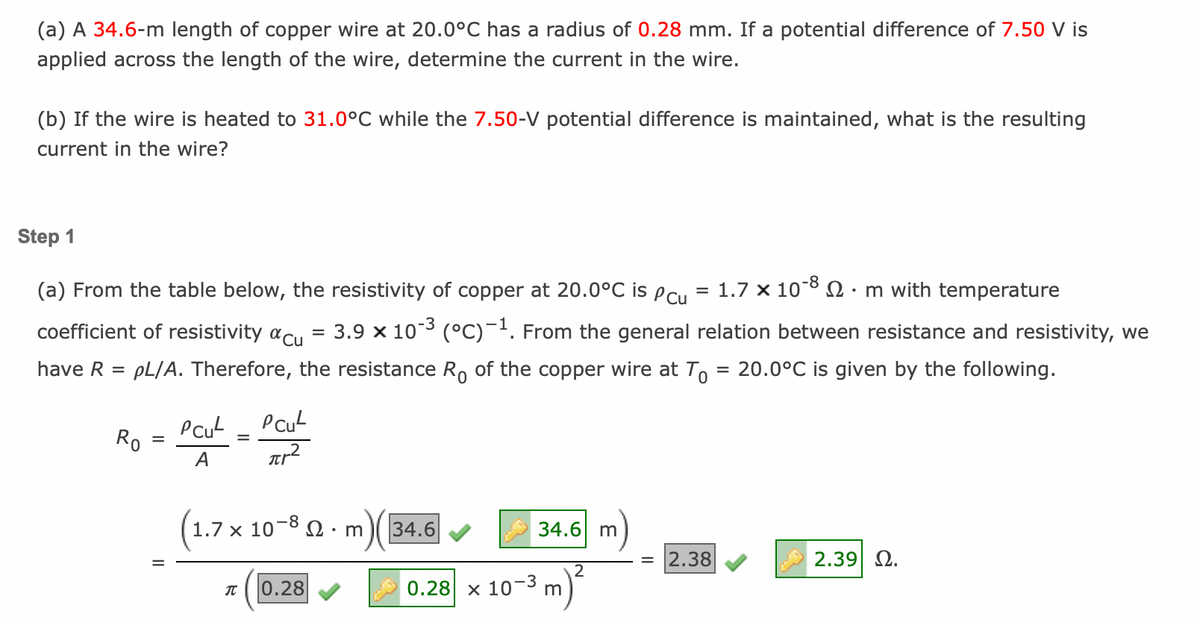(b) At T = 31.0°C, the resistance is given by R = Ro[1 + a(T-To)], where a is the temperature coefficient of resistivity. The current in the copper wire becomes AV Ro[1 + acu(T-To)] I = = AV R = 2.39 M)1 + (3.9 × 10-³ (°C)-¹)( 31.0 Your response differs from the correct answer by more than 100%. °C 7.5 A.
(b) At T = 31.0°C, the resistance is given by R = Ro[1 + a(T-To)], where a is the temperature coefficient of resistivity. The current in the copper wire becomes AV Ro[1 + acu(T-To)] I = = AV R = 2.39 M)1 + (3.9 × 10-³ (°C)-¹)( 31.0 Your response differs from the correct answer by more than 100%. °C 7.5 A.
Physics for Scientists and Engineers: Foundations and Connections
1st Edition
ISBN:9781133939146
Author:Katz, Debora M.
Publisher:Katz, Debora M.
Chapter28: Current And Resistance
Section28.3: Current Density
Problem 28.3CE
Related questions
Question
100%
26.12

Transcribed Image Text:(a) A 34.6-m length of copper wire at 20.0°C has a radius of 0.28 mm. If a potential difference of 7.50 V is
applied across the length of the wire, determine the current in the wire.
(b) If the wire is heated to 31.0°C while the 7.50-V potential difference is maintained, what is the resulting
current in the wire?
Step 1
(a) From the table below, the resistivity of copper at 20.0°C is Pcu
coefficient of resistivity Cu
have R =
pL/A. Therefore, the resistance Ro of the copper wire at To
=
Ro
=
Pcu
A
=
PCu²
πr²
-8
1.7 x 10 m with temperature
3.9 x 10-3 (°C)-¹. From the general relation between resistance and resistivity, we
20.0°C is given by the following.
(1.7 x
1.7 x 10-8 m
JU 0.28
m)( 34.6
34.6 m
0.28 x 10-3 m
2
=
2.38
2.39| Ω.
![Step 2
When a 7.50-V potential difference is applied across the length of this wire at 20.0°C, the resulting current Io
is
Io
I =
=
AV
Ro
II
AV
R
7.50
Step 3
=
(b) At T = 31.0°C, the res tance is given by R
resistivity. The current in the copper wire becomes
2.39
2.39
7.5 V
2.39| Ω
AV
Ro[1 + acu(T - To)]
A.
3.13
7.5
3.14 A.
Ro[1 + a(TTO)], where a is the temperature coefficient of
v)
Ω 1 + (3.9 x 10-³ (°C)-¹)(
31.0
Your response differs from the correct answer by more than 100%.°](/v2/_next/image?url=https%3A%2F%2Fcontent.bartleby.com%2Fqna-images%2Fquestion%2F91ed8060-678c-4d36-a5c7-0e7a65a577a0%2Fa4f1720c-4ea2-44f0-81b9-1e7962cd02db%2F03pcyjk_processed.png&w=3840&q=75)
Transcribed Image Text:Step 2
When a 7.50-V potential difference is applied across the length of this wire at 20.0°C, the resulting current Io
is
Io
I =
=
AV
Ro
II
AV
R
7.50
Step 3
=
(b) At T = 31.0°C, the res tance is given by R
resistivity. The current in the copper wire becomes
2.39
2.39
7.5 V
2.39| Ω
AV
Ro[1 + acu(T - To)]
A.
3.13
7.5
3.14 A.
Ro[1 + a(TTO)], where a is the temperature coefficient of
v)
Ω 1 + (3.9 x 10-³ (°C)-¹)(
31.0
Your response differs from the correct answer by more than 100%.°
Expert Solution
This question has been solved!
Explore an expertly crafted, step-by-step solution for a thorough understanding of key concepts.
Step by step
Solved in 2 steps with 2 images

Knowledge Booster
Learn more about
Need a deep-dive on the concept behind this application? Look no further. Learn more about this topic, physics and related others by exploring similar questions and additional content below.Recommended textbooks for you

Physics for Scientists and Engineers: Foundations…
Physics
ISBN:
9781133939146
Author:
Katz, Debora M.
Publisher:
Cengage Learning

Physics for Scientists and Engineers: Foundations…
Physics
ISBN:
9781133939146
Author:
Katz, Debora M.
Publisher:
Cengage Learning